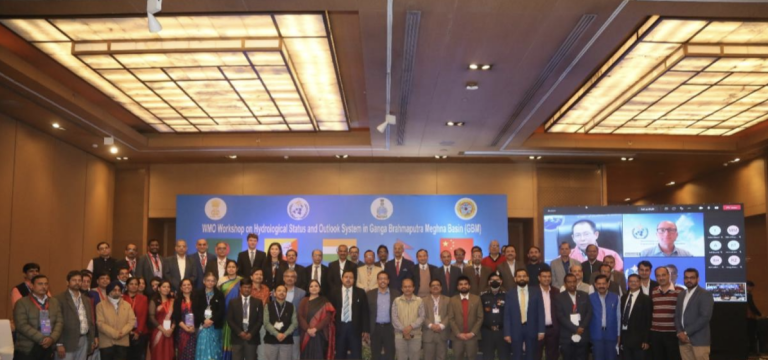WMO HydroSOS in Ganga Brahmaputra Meghna Basin
The World Meteorological Organization and India Meteorological Department (IMD) have held a two-day regional workshop on the proposed Hydrological Status and Outlook System (HydroSOS) in the Ganga Brahmaputra Meghna (GBM) River Basin.

The World Meteorological Organization and India Meteorological Department (IMD) have held a two-day regional workshop on the proposed Hydrological Status and Outlook System (HydroSOS) in the Ganga Brahmaputra Meghna (GBM) River Basin.
The Ganga Brahmaputra Meghna (GBM) Basin is shared by Bhutan, Bangladesh, India and Nepal and is spread over 1.7 million square kilometers. It has a population of more than 500 million, making it one of the most populated river basins in the world.
The basin faces many challenges, leading to inadequate water resources management. Floods and droughts are common, with enormous environmental, social and economic consequences.
The development and implementation of a free, open-source, and sustainable HydroSOS would be a major step forward for water management and disaster risk reduction in the basin. Specifically, it would boost the operational capabilities of National Meteorological and Hydrological Services, water managers and institutions responsible for flood and drought monitoring, forecasting and warnings.
“HydroSOS will enhance the capabilities of sub-seasonal to seasonal prediction and impact-based climate and weather forecasting modelling system for predicting available water status and its outlook. We appreciate the effort of WMO in building such programmes across the countries for improving the forecasting of riverine basins. The initiative of HydroSOS calls us to work together,” said Dr. M. Ravichandran, Secretary of Ministry of Earth Science, Government of India, in an opening address.

WMO Director of Water and Cryosphere, Dr Johannes Cullmann, highlighted the importance of multi-stakeholder involvement and scientific tools and products as the basis of solutions and services for climate change adaptation and sustainable development. HydroSOS embodies this approach and would bring major benefits not only in the GBM basin but also in other basins of the world, he said.
HydroSOS is being developed by WMO and partners as a global operational global system capable of assessing the current and forecast status of surface and groundwater hydrological systems.
While the system’s information and products will be global, they will also be provided at regional and national scales. The operational system will support the activities of National Meteorological and Hydrological Services and will provide easily accessible hydrological information and products that can be made accessible to government bodies, regional and international aid agencies, and the general public.
The HydroSOS project pre-concept for the GBM basin will be finalized and submitted to the Adaptation Fund during January 2022 for funding.
The two-day hybrid regional workshop on 22-23 November was organized as a consultation with stakeholders in GBM countries in order to create a common understanding of the proposed project objectives, benefits and implementation strategy. This is a pre-requisite for the successful development and implementation of the project from regional to national to community level.
The Chair of India’s Central Water commission, WMO Permanent Representatives of the GBM countries, and about 50 officials from various government organizations of Bangladesh, Bhutan, China, India, Nepal and the WMO Secretariat participated.
The workshop provided opportunity to foster high-level commitment and leadership for the various stages of the project development and implementation mainly clarifying roles and responsibilities of different national partners engaged.
The inaugural ceremony can be viewed here.
- WMO Member:
- Bhutan ,
- Bangladesh ,
- India ,
- Nepal









